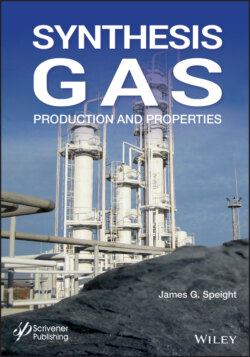Читать книгу Synthesis Gas - James Speight G., James G. Speight - Страница 44
2.5.1 Feedstock Pretreatment
ОглавлениеWhile feedstock pretreatment for introduction into the gasifier is often considered to be a physical process in which the feedstock is prepared for gasifier – typically as pellets or finely ground feedstock – there are chemical aspects that must also be considered. Some feedstocks, especially certain types of coal, display caking, or agglomerating, characteristics when heated (Speight, 2013) and these coal types are usually not amenable to treatment by gasification processes employing fluidized-bed or moving-bed reactors; in fact, caked coal is difficult to handle in fixed-bed reactors. The pretreatment involves a mild oxidation treatment which destroys the caking characteristics of coals and usually consists of low-temperature heating of the coal in the presence of air or oxygen.
While this may seemingly be applicable to coal gasification only, this form of coal pretreatment is particularly important when a non-coal feedstock is co-gasified with coal. Co-gasification of other feedstocks, such as coal and especially biomass, with crude oil coke offers a bridge between the depletion of crude oil stocks when coal is used as well as a supplementary feedstock based on renewable energy sources (biomass). These options can contribute to reduce the crude oil dependency and carbon dioxide emissions since biomass is known to be neutral in terms of carbon dioxide emissions. The high reactivity of biomass and the accompanying high production of volatile products suggest that some synergetic effects might occur in simultaneous thermochemical treatment of petcoke and biomass, depending on the gasification conditions such as: (i) feedstock type and origin, (ii) reactor type, and (iii) process parameters (Penrose et al., 1999; Gray and Tomlinson, 2000; McLendon et al., 2004; Lapuerta et al., 2008; Fermoso et al., 2009; Shen et al., 2012; Khosravi and Khadse, 2013; Speight, 2013, 2014a, 2014b; Luque and Speight, 2015).
The first step in the process is feedstock preparation which may include unit operations such as (i) size reduction, (ii) screening, and (iii) slurrying. The design of the feedstock preparation section depends on the properties of the raw material feed and on the requirements of the gasification technology that is selected. For example, preparing any form of crude oil resid, biomass, or waste for gasification is very different from the preparation of bituminous coal for the gasifier, and the type of gasifier suitable for the gasification may also (or more than likely) be feedstock dependent (Chapter 12).
For example, carbonaceous fuels are gasified in reactors, a variety of gasifiers such as the fixed- or moving-bed, fluidized-bed, entrained-flow, and molten-bath gasifiers have been developed (Shen et al., 2012; Speight, 2014b). If the flow patterns are considered, the fixed-bed and fluidized-bed gasifiers intrinsically pertain to a countercurrent reactor in that fuels are usually sent into the reactor from the top of the gasifier, whereas the oxidant is blown into the reactor from the bottom. With regard to the entrained-flow reactor, it is necessary to pulverize the feedstock (such as coal and petcoke). On the other hand, when the feedstock is sent into an entrained-flow gasifier, the fuels can be in either form of dry feed or slurry feed. In general, dry-feed gasifiers have the advantage over slurry-feed gasifiers in that the former can be operated with lower oxygen consumption. Moreover, dry-feed gasifiers have an additional degree of freedom that makes it possible to optimize synthesis gas production (Shen et al., 2012).
